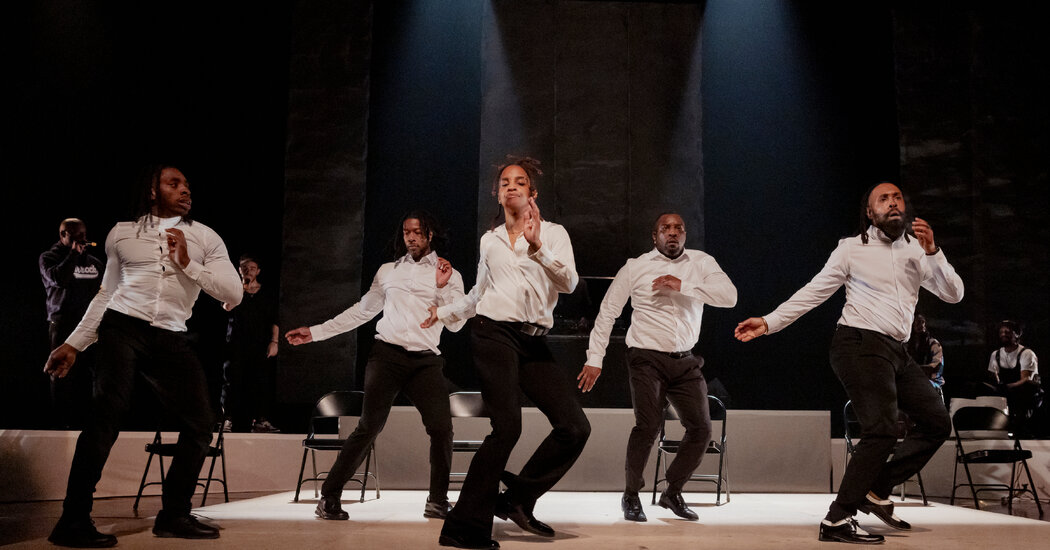American dance has African roots, traceable by rhythm.
Countless dance productions have tried to turn that history into theater, the latest being “American Street Dancer,” a work by Rennie Harris Puremovement that is getting its New York debut at the Joyce Theater this week. But don’t expect a lecture. This show’s grace is to do more showing than telling; its generosity is to honor the past while never ceasing to entertain in the present.
Harris has done more than any other choreographer to reveal and develop the metaphorical and narrative expressivity of American street dance. But this isn’t that kind of performance.
After a standard “it all started in Africa” opening, the evening is essentially a variety show highlighting a few regional styles: Chicago footwork, Detroit Jit and Philly GQ, each represented with hometown pride by a local crew. A live band of bucket drummers, beatboxers and DJ Razor Ramon provides the accompaniment as well as musical interludes. The show’s 80 minutes mostly fly by.
The incisive Djembe drumming of Brytiece Wallace sets the scene. Akim Funk Buddha ripples bodily suggestions of South African gumboot dancing and the Middle Passage. Then Ayodele Casel arrives to fast-forward the tale into thrillingly contemporary virtuosity.
Casel’s tap dancing is lightning fast and state of the art, but it carries identifiable memories of the steps of ancestors: Bill Robinson, Chuck Green, Gregory Hines, even Hines’s version of African dance. Her section establishes a format in which Harris’s recorded voice asks questions that the performers onstage answer in dance.
At the end of her section, Casel turns down the volume on her clicking toes and heels. It’s a perfect transition to the lip, tongue and teeth noises of the beatboxers who follow. This is how “American Street Dancer” makes its points about continuity. Hands on drums are related to feet on the floor, as well as to mouths on microphones and fingers on turntables.
Those beatboxers (Buddha, Alexander Sanchez, Kenny Muhammad) are human drum machines and sound-effect generators, conjuring beats, growls, buzzes, James Brown grunts and crying babies. When Muhammad puts the mic to his neck, it sounds like we’re hearing a club from the outside; when he moves the mic to his mouth, the club door opens. Later, the bucket drummers twirl their sticks, and when DJ Ramon gets his solo spot, he’s a showman, too, juggling the beat between turntables, behind his back and under his legs. He also manipulates records with his nose.
The effect of technology is another theme, left mostly implicit. A distinguishing feature of Chicago footwork is its manic speed, measured at 160 beats per minute. The members of Creation Global keep the pace with frantic feet and shifting formations, each dancer adding individual flare. As later represented by House of Jit, the Detroit style is clearly a product of the city that produced techno, but the electronic futurism doesn’t disguise the tracks of Motown and the tap traditions that Motown kept current.
Harris saves his own Philly form for last, which works: It’s the funkiest and most suavely engaging, and not just because of the bowler hats and suits that the Puremovement dancers sport, or gestures of dapper nonchalance like brushing off their shoulders and flashing handkerchiefs. It’s the grounding in the Afro-Latin Cha Cha. In between flips and splits, the dancers keep returning to a tasty footwork groove, giving the GQ routines a formal coherence the others lack.
In a voice-over, Harris notes that GQ, a dance of the 1960s to the ’80s, isn’t done much in the wild anymore. He’s honorably preserving it. After the bows, the whole cast of “American Street Dancer” acts out the natural way of things in an all-styles jam session. As dancers take solo turns in the center of the circle, the family resemblances are visible. But so is a sense of continual borrowing. This nationwide house party started long ago, and it shows no signs of shutting down.
Rennie Harris Puremovement
Through Sunday at the Joyce Theater, Manhattan; joyce.org.
The post Review: Rennie Harris’s Jam Session of American Street Dance appeared first on New York Times.




